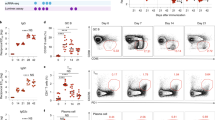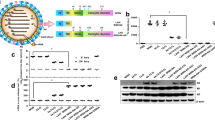Abstract
Apoptotic bodies can be used to target delivery of DNA-expressed immunogens into professional antigen-presenting cells (APCs). Here we show that antigen-laden apoptotic bodies created by vectors co-expressing influenza virus hemagglutinin (HA) or nucleoprotein (NP) genes and mutant caspase genes markedly increased T-cell responses. Both CD8 and CD4 T-cell responses were affected. The adjuvant activity was restricted to partially inactivated caspases that allowed immunogen expression before the generation of apoptotic bodies. Active-site mutants of murine caspase 2 and an autocatalytic chimera of murine caspase 2 prodomain and human caspase 3 induced apoptosis that did not interfere with immunogen expression. The adjuvant activity also enhanced B-cell responses, but to a lesser extent than T-cell responses. The large increases in T-cell responses represent one of the strongest effects to date of a DNA adjuvant on cellular immunity.
This is a preview of subscription content, access via your institution
Access options
Subscribe to this journal
Receive 12 print issues and online access
$209.00 per year
only $17.42 per issue
Buy this article
- Purchase on Springer Link
- Instant access to full article PDF
Prices may be subject to local taxes which are calculated during checkout






Similar content being viewed by others
References
Robinson, H.L. & Pertmer, T.M. DNA vaccines for viral infections: basic studies and applications. In Advances in virus research. (eds Maramorosch, K., Murphy, F.A. & Shatkin, A.J.) 1–74 (Academic Press, New York, NY; 2000).
Gurunathan, S., Klinman, D.M. & Seder, R.A. DNA vaccines: immunology, application, and optimization. Annu. Rev. Immunol. 18, 927–974 (2000).
Albert, M.L. Sauter, B. & Bhardwaj, N. Dendritic cells acquire antigen from apoptotic cells and induce class I-restricted CTLs. Nature 392, 86–89 (1998).
Albert, M.L. et al. Immature dendritic cells phagocytose apoptotic cells via αvβ5 and CD36, and cross-present antigens to cytotoxic T lymphocytes. J. Exp. Med. 188, 1359–1368 (1998).
Sigal, L.J., Crotty, R., Andino, R. & Rock, K. Cytotoxic T-cell immunity to virus-infected non-haematopoietic cells requires presentation of exogenous antigen. Nature 398, 77–80 (1999).
Spetz, A.L., Patters, B.K., Lore, K. Anderson, J. & Holmgren, L. Functional gene transfer of HIV DNA by and HIV receptor-independent mechanism. J. Immunol. 163, 736–742 (1999).
Holmgren, L. et al. Horizontal transfer of DNA by the uptake of apoptotic bodies. Blood 93, 3956–3963 (1999).
Chattergoon, M.A. et al. Target antigen delivery to antigen-presenting cells including dendritic cells by engineered Fas-mediated apoptosis. Nat. Biotechnol. 18, 974–979 (2000).
Salvesen, G.S. & Dixit, V.M. Caspases: Intracellular signaling by proteolysis. Cell 91, 443–446 (1997).
Nicholson, D.W. & Thornberry, N.A. Caspases: killer proteases. Trends Biochem. Sci. 22, 299–306 (1997).
Colussi, P.A., Harvey, N.L. & Kumar, S. Prodomain-dependent nuclear localization of the caspase-2 (Nedd2) precursor. A novel function for a caspase prodomain. J. Biol. Chem. 273, 24535–24542 (1998).
Collusi, P.A., Harvey, N.L. Shearwin-Whyatt, L.M. & Kumar, S. Conversion of procaspase-3 to an autoclaving caspase by fusion to the caspase-2 prodomain. J. Biol. Chem. 273, 26566–26570 (1998).
Butt, A.J., Harvey, N.L., Parasivam, G. & Kumar, S. Dimerization and autoprocessing of the Nedd2 (caspase-2) precursor requires both the prodomain and the carboxyl-terminal regions. J. Biol. Chem. 273, 6763–6768 (1998).
Waldrop, S.L., Davis, K.A., Maino, V.C. & Picker, L.J. Normal human CD4++ memory T cells display broad heterogeneity in their activation threshold for a cytokine synthesis. J. Immunol. 161, 5284–5295 (1998).
Torres, C.A., Yang, K., Mustafa, F. & Robinson, H.L. DNA immunization: effect of secretion of DNA-expressed hemagglutinin on antibody responses. Vaccine 18, 805–814 (1999).
Sauter, B. et al. Consequences of cell death: exposure to necrotic tumor cells, but not primary tissue cells or apoptotic cells, induces the maturation of immunostimulatory dendritic cells. J. Exp. Med. 191, 423–434 (2000).
Hemmi, H. et al. A toll-like receptor recognizes bacterial DNA. Nature 408, 740–745 (2000).
Ross, T.M., Xu, Y., Bright, R.A. & Robinson, H.L. C3d enhancement of antibodies to hemagglutinin accelerates protection against influenza virus challenge. Nat. Immunol. 1, 127–131 (2000).
Pertmer, T.M., Oran, A.W., Moser, J.M., Madorin, C.A. & Robinson, H.L. DNA vaccines for influenza virus: differential effects of maternal antibody on immune responses to hemagglutinin and nucleoprotein. J. Virol. 74, 7787–7793 (2000).
Winter, G., Fields, S. & Brownlee, G.G. Nucleotide sequence of the hemagglutinin gene of a human influenza virus H1 subtype. Nature 292, 72–75 (1981).
Gao, X.M., Liew, F.Y. & Tite, J.P. Identification and characterization of T helper epitopes in the nucleoprotein of influenza A virus. J. Immunol. 143, 3007–3014 (1989).
Robinson, H.L. et al. DNA immunization for influenza virus: studies using hemagglutinin and nucleoprotein-expressing DNAs. J. Infect. Dis. 176, S50–S55 (1997).
Acknowledgements
This work was supported by US Public Health Service research grant R01AI34946 and base grant support to Yerkes Regional Primate Research Center, RR00165. We would like to thank H. Drake-Perrow for expert administrative assistance.
Author information
Authors and Affiliations
Corresponding author
Rights and permissions
About this article
Cite this article
Sasaki, S., Amara, R., Oran, A. et al. Apoptosis-mediated enhancement of DNA-raised immune responses by mutant caspases. Nat Biotechnol 19, 543–547 (2001). https://doi.org/10.1038/89289
Received:
Accepted:
Issue Date:
DOI: https://doi.org/10.1038/89289
This article is cited by
-
Induction of antigen‐positive cell death by the expression of Perforin, but not DTa, from a DNA vaccine enhances the immune response
Immunology & Cell Biology (2014)
-
Role of innate signalling pathways in the immunogenicity of alphaviral replicon-based vaccines
Virology Journal (2011)
-
DNA vaccines for cancer too
Cancer Immunology, Immunotherapy (2006)
-
DNA vaccines for HIV: challenges and opportunities
Springer Seminars in Immunopathology (2006)
-
‘Survival gene’ Bcl-xl potentiates DNA-raised antitumor immunity
Gene Therapy (2005)



